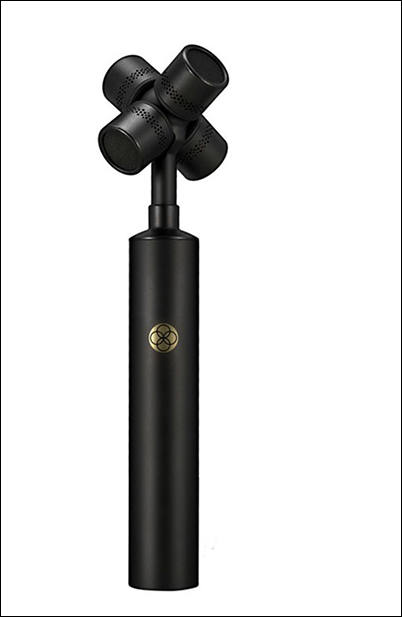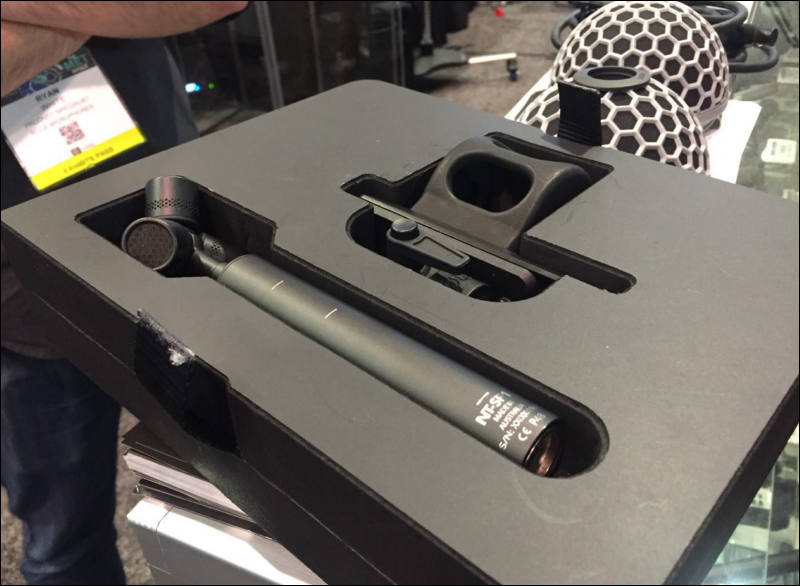
-

The first product for the SoundField By RØDE family is a marriage of SoundField’s pristine ambisonic recording technology, and RØDE’s commitment to audio excellence accessible by all creators. Completely designed and made in Australia at RØDE’s Sydney campus, the NT-SF1 is a triumph of innovation and manufacturing quality. Featuring four of RØDE’s all-new, ultra-quiet ½-inch TF45C capsules in tetrahedral array, the NT-SF1 produces natural, transparent four channel A-format recordings which can be transformed and manipulated in B-Format, courtesy of the soon-to-be-released SoundField by RØDE plugin.
“When The Freedman Group acquired SoundField in late-2016, the aim was to continue producing the premier 360-degree audio capture loved by the professionals who bring us cinema sound and 7.1 broadcast,” says Freedman Group CEO Damien Wilson. “And we are. But, as is the RØDE way, we have brought our manufacturing and design expertise to bear on this new family of microphones. The SoundField By RØDE NT-SF1 is for creators for whom the ultra-high-end SoundField products are out of reach, and delivers results unmatched by all but the most expensive ambisonic microphones.”
Head of RØDE’s New Product Development and former Director of New Product at SoundField for 16 years, Pieter Schillebeeckx, says this is the most exciting development in the technology in decades. “Delivering this kind of professional-use technology at a sub-USD$1000 price point is a world first in the ambisonic world,” he says. “It gives budding VR creators, immersive filmmakers and videogame world builders an accessible and high-quality way to dive into 360-degree-with-height audio capture.”
Due to release soon in 2018, the SoundField By RØDE NT-SF1 will democratise one of the last bastions of high-end recording the way RØDE has always done: with precision, price and unbeatable after-sales service.
-
Our photo from NAB

Interview will be posted soon.

 sa2690.jpg800 x 586 - 59K
sa2690.jpg800 x 586 - 59K -
This is the first sub US$1K ambisonic mic, but if Rode doesn't work with Zoom / Sound Devices MixPre to support B format decoding then it probably makes sense to spend the extra to buy a Sennheiser AMBEO instead.
Maybe, need to wait and see how this pans out once it gets released to hear just how good it is.
-
This is the first sub US$1K ambisonic mic, but if Rode doesn't work with Zoom / Sound Devices MixPre to support B format decoding then it probably makes sense to spend the extra to buy a Sennheiser AMBEO instead.
Sometimes I am amazed in you.
It is set of 4x $15 factory cost (at best!) microphone capsules, $10 metal case, $40 tops preamps. Add here few plastic things included for $15.
Also I do not get all this about B format and such. As only real advanced software can be used to make something more or less reliable from this extremely outdated design.
-
Sure I could make my own DIY mic for a lot less than half the price but would that possibly put off a producer from hiring me? Absolutely yes.
Likewise with B format, you never know how experienced or rather inexperienced post might be so you're better off giving them the simplest files to work with. Is that worth a few hundred dollars extra? Likely yes it is.
-
Out interview, made upon @IronFIlm request
-
I guess the Zoom F8 could support the Rode NT-SF1 with the firmware update.
-
-
@Vitaliy I meant B format support but it seems they already did it. https://wavreport.com/2017/09/29/this-week-in-firmware-mixpre6-f8/
-
@mirrorman , that is not for the Rode, no one supports it yet (other than A format of course which is true for all mics).
-
SoundField by RØDE Plugin
-
Shipping now
-
Going to see very soon independent reviews! NT-SF1 vs SPS200 is what I most importantly want to see. Although NT-SF1 vs H3VR would be interesting too but I expect Rode to outperform the Zoom.
-
The Rode plugin is really good when used with other mics. I use a 90 degree pair of fig-8 ribbons and a small omni in between, fed into X, Y and W inputs of the Rode plug-in, and you end up with a fantastic steerable stereo image and variable polar patterns. Audio quality is a lot better than other ambisonic plug-ins I’ve tried and the plugin is free!
-
@Mike_the_Harp. Nice! Appreciate knowing.
-
He gave a rave review of the Rode NT-SF1:
Howdy, Stranger!
It looks like you're new here. If you want to get involved, click one of these buttons!
Categories
- Topics List23,970
- Blog5,724
- General and News1,346
- Hacks and Patches1,153
- ↳ Top Settings33
- ↳ Beginners255
- ↳ Archives402
- ↳ Hacks News and Development56
- Cameras2,360
- ↳ Panasonic990
- ↳ Canon118
- ↳ Sony155
- ↳ Nikon96
- ↳ Pentax and Samsung70
- ↳ Olympus and Fujifilm100
- ↳ Compacts and Camcorders300
- ↳ Smartphones for video97
- ↳ Pro Video Cameras191
- ↳ BlackMagic and other raw cameras117
- Skill1,961
- ↳ Business and distribution66
- ↳ Preparation, scripts and legal38
- ↳ Art149
- ↳ Import, Convert, Exporting291
- ↳ Editors191
- ↳ Effects and stunts115
- ↳ Color grading197
- ↳ Sound and Music280
- ↳ Lighting96
- ↳ Software and storage tips267
- Gear5,414
- ↳ Filters, Adapters, Matte boxes344
- ↳ Lenses1,579
- ↳ Follow focus and gears93
- ↳ Sound498
- ↳ Lighting gear314
- ↳ Camera movement230
- ↳ Gimbals and copters302
- ↳ Rigs and related stuff272
- ↳ Power solutions83
- ↳ Monitors and viewfinders339
- ↳ Tripods and fluid heads139
- ↳ Storage286
- ↳ Computers and studio gear560
- ↳ VR and 3D248
- Showcase1,859
- Marketplace2,834
- Offtopic1,319








